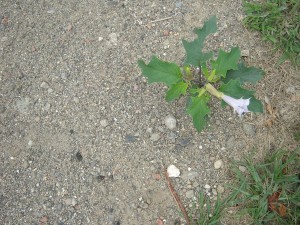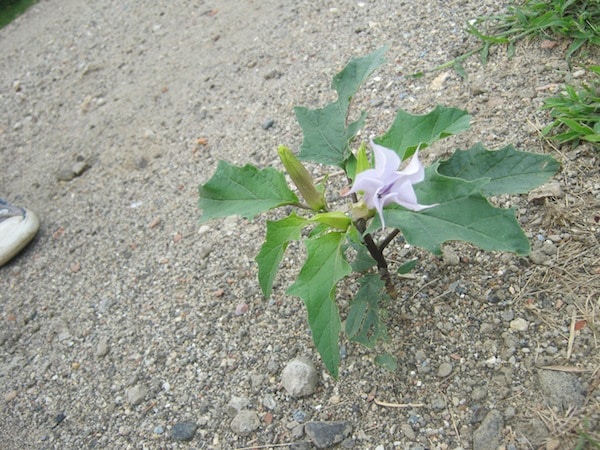• by Dr. Sarah Oktay, Director, University of Massachusetts Nantucket Field Station
Summer and early fall apparently are a Nantucket playground for the Devil’s snare plant. If you are a lover of the Harry Potter books you may remember Devil’s snare as a large strangling, treacherous plant that Harry, Hermione, and Ron and other characters encountered (http://sp13ethnobotany.providence.wikispaces.net/Devil’s+Snare). Fortunately, in our world, Devil’s snare is not deliberately trying to kill us. But it is a dangerous plant and also an insidious one, lurking in piles of displaced soil and popping out indiscriminately along the roadside. Devil’s snare is better known as jimsonweed and is common on Nantucket, easily found in areas with freshly disturbed soil and along roadside in piles of loose dirt. While removing trash from a soil/sand pile near Low Beach for the Clean Team a few weeks ago I saw at least a dozen plants popping out of the loose soil. You should be careful removing this plant, wear gloves and make sure to throw it into the digester at the dump.
The Latin name for jimsonweed is Datura stramonium. The genus name datura is also sometimes used as its common name and it comes from the Hindu name for the plant “dhatura”. Hindus were one of the first people to use it as a medicine and sacred plant. It was believed to be a favorite of the Hindu god Shiva Nataraja. Stramonium is originally from a compilation of the Greek words, “strychnos” for “nightshade” and “maniakos” for “mad; somehow it migrated through New Latin to mean spiked fruit (http://bioweb.uwlax.edu/bio203/2011/hart_cale/classification.htm) which makes sense because the seed pod of the jimsonweed is very spiky.

Jimsonweed is a member of the Solanaceae (nightshade) family. It is believed to have originated in the Americas, but is now found around the world. Other common names for D. stramonium include thornapple, moon flower, hell’s bells (a junior ranger favorite name), Devil’s trumpet, Devil’s weed, Tolguacha, Jamestown weed, stinkweed, locoweed, pricklyburr and Devil’s cucumber. Apparently the Devil is into gardening. Other members of the nightshade family include mandrake, belladonna, and common plants like potatoes, tomatoes, and bell peppers. The order in which jimsonweed resides is Solanales which includes the potatoes and the family (Solanacae) includes tomato plants.
This native plant is easy to identify due to its odd appearance and even easier to remember because it has played such a big role in sacred and not so sacred uses. It has beautiful white trumpet shaped flowers with purple swirls. D. stramonium is a foul-smelling, erect annual, freely branching herb that forms a bush up to 2 to 5 feet (60–150 cm) tall. The root is long, thick, fibrous and white. The stem is stout, erect, leafy, smooth, and pale yellow-green. The stem forks off repeatedly into branches, and at each fork it forms a leaf and a single, erect flower. The leaves are approximately 3 to 8 inches (8–20 cm) long, smooth, very obviously pointy or “toothed”, soft, and irregularly undulate (having a wavy surface or edge). The upper surface of the leaves is a darker green, and the bottom is a light green. Datura stramonium generally flowers throughout the summer. The fragrant flowers are trumpet-shaped, white to creamy or violet, and 2 1⁄2 to 3 1⁄2 inches (6–9 cm) long, and grow on short stems from either the axils of the leaves or the places where the branches fork. The calyx is long and tubular, swollen at the bottom, and sharply angled, surmounted by five sharp teeth. The corolla, which is folded and only partially open, is white, funnel-shaped, and has prominent ribs. The flowers open at night (hence the name moon flower), emitting a pleasant fragrance (versus the stink from the leaves) and is fed upon by nocturnal moths.
The egg-shaped seed capsule is 1 to 3 inches (3–8 cm) in diameter and either covered with spines or bald. At maturity it splits into four chambers, each with dozens of small black seeds.
Cornell University does an excellent job informing the public about invasive and toxic plants and their website on jimsonweed does not disappoint (http://www.ansci.cornell.edu/plants/jimsonweed/jimsonweed.html). They list the symptoms of poisoning from jimsonweed which includes rapid pulse and breathing, nervousness, dilated pupils, and muscular twitching. The psychotropic and medicinal properties of jimsonweed can turn toxic and even deadly with small differences in the amount of plant ingested. Plants concentration of the toxic ingredients vary greatly from plant to plant and change as the plants get older (usually becoming a bit safer). Jimsonweed poisoning occurs when someone sucks the juice or eats the seeds from this plant. You can also be poisoned by drinking tea made from the leaves.
This hallucinogenic property of jimsonweed led to its being called Jamestown weed; it got this name from the town of Jamestown, Virginia, where British soldiers consumed it while attempting to suppress Bacon’s Rebellion in 1676. The junior rangers and Len Germinara, our education coordinator at the Nantucket Field Station delight in regaling visitors of the tale of young British nitwit soldiers not understanding that the plant they picked to make a salad would result in hallucinations and epic levels of silliness. Basically the soldiers were completely incapacitated and laid in heaps upon the ground consumed by the visions in their heads. As told by Robert Beverly in “The History and Present State of Virginia (1705) ”: The soldiers presented “a very pleasant comedy, for they turned natural fools upon it for several days: one would blow up a feather in the air; another would dart straws at it with much fury; and another, stark naked, was sitting up in a corner like a monkey, grinning and making mows at them; a fourth would fondly kiss and paw his companions, and sneer in their faces with a countenance more antic than any in a Dutch droll.
“In this frantic condition they were confined, lest they should, in their folly, destroy themselves – though it was observed that all their actions were full of innocence and good nature. Indeed they were not very cleanly; for they would have wallowed in their own excrements, if they had not been prevented. A thousand such simple tricks they played, and after 11 days returned themselves again, not remembering anything that had passed.” (http://en.wikipedia.org/wiki/Datura_stramonium). Good times!
Livestock are also susceptible to poisoning by jimsonweed and all plants have to be removed before a field can be used for fodder. The leaves and seeds do not smell good and that discourages most people and animals from eating them, but when they are tilled up with hay or field fodder, they can quickly become a problem for livestock.
For centuries D. stramonium has been used as an herbal medicine to relieve asthma symptoms (more about that below) and as an analgesic during surgery or bonesetting. It is also a powerful hallucinogen and deliriant (causes delirium), which was used spiritually for the intense visions it produces. However, the tropane alkaloids which are responsible for both the medicinal and hallucinogenic properties are fatally toxic in only slightly higher amounts than the medicinal dosage, and careless use often results in hospitalizations and deaths. The active ingredients in a jimson weed plant include atropine, hyoscine (scopolamine- used for motion sickness) hyoscyamine and tropane alkaloids. Hyoscyamine is an anticholinergic agent which means it blocks the neurotransmitter acetylcholine in the central and the peripheral nervous system. Anticholinergics inhibit parasympathetic nerve impulses by selectively blocking the binding of the neurotransmitter acetylcholine to its receptor in nerve cells. The nerve fibers of the parasympathetic system are responsible for the involuntary movement of smooth muscles present in the gastrointestinal tract, urinary tract, lungs, etc. Hyoscyamine is an antispasmodic that helps prevent painful or involuntary muscle movement. Atropine dilates the pupils, increases heart rate, and reduces salivation and other secretions. It is on the World Health Organization’s List of Essential Medicines, a list of the most important medications needed in a basic health system. The substances above combined have produced at least 100 essential medicines.
Most plants in the nightshade family are used in some manner for motion sickness because they contain hyoscine or scopolamine. As an oceanographer, scopolamine patches have saved my bacon on a few cruises but you can feel the effects and it isn’t hard to see that more than one patch would be a bad idea. Jimsonweed has been used as a treatment for asthma for centuries. The active anti-asthmatic agent is atropine, which causes paralysis of the pulmonary branches of the lungs, eliminating the spasms that cause the asthma attacks. The leaves are generally smoked either in a cigarette or a pipe. This practice of smoking datura to relieve asthma has its origins in traditional Ayurvedic medicine in India. The Zuni used to use datura as an analgesic, to render patients unconscious while broken bones were set. The Chinese also used it in this manner, as a form of anesthesia during surgery. Atropine and scopolamine (both of which are found in very high concentrations in datura) are muscarinic antagonists which can be used to treat Parkinson’s disease and motion sickness, and to inhibit parasympathetic stimulation of the urinary tract, respiratory tract, GI tract, heart and eye. The dilation properties of the plant have been used to help patients undergoing eye surgery.
The legends and stories associated with jimsonweed are extensive. The use of the plant has even been linked to zombies! Haitians voodoo sorcerers or bokors supposedly would administer D. stramonium – known as not only the Devil’s cucumber but zombie cucumber to people paralyzed by tetrodotoxin. The jimsonweed would allow the bokor to enslave the victims because it causes memory loss (sometimes even severe amnesia) and disorientation. Wow! Think about that next time you are having a bad day. I have always appreciated the beauty of jimsonweed and its tenaciousness and now I am even more impressed by its ability to heal people and its deadly power. So look, but don’t touch and remove it from your garden if small children or bokors are around.



